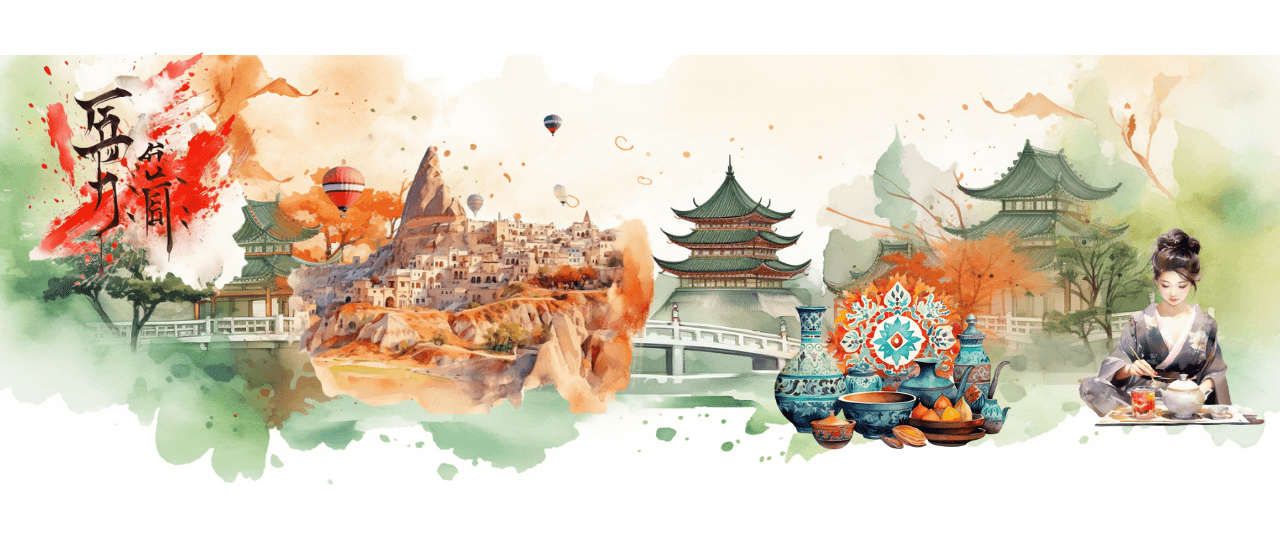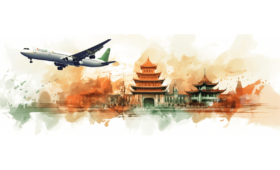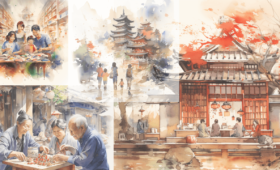Discover the heart and soul of Earth’s largest and most diverse continent through authentic cultural experiences in Asia. This vast region, steeped in ancient traditions and brimming with vibrant modernity, offers a treasure trove of unique and enriching experiences far beyond the usual tourist paths. Whether it’s participating in a traditional tea ceremony in the serene setting of Kyoto, exploring the intricate art of carpet weaving in Uzbekistan, or embarking on a spiritual journey in the ancient temples of Bagan, each experience promises to deepen your understanding and appreciation of Asia’s rich cultural tapestry. From the bustling street markets of George Town to the tranquil Zen meditation sessions in Japan, authentic cultural experiences in Asia are not just travel moments; they are gateways to understanding the diverse histories, philosophies, and ways of life that make this continent so endlessly fascinating. Join us as we explore Asia’s myriad of authentic cultural experiences, providing memories and insights into some of the world’s most ancient and enduring cultures.
Traditional tea ceremony in Kyoto- Japan
The traditional tea ceremony, known as “Sado” or “Chado” in Japan, is more than just a cultural activity; it’s a spiritual and philosophical experience deeply rooted in Zen Buddhism. Kyoto, with its rich history and preservation of Japanese traditions, offers an authentic setting for experiencing this unique aspect of Japanese culture.
Best Time to Visit
Seasons: Spring (March to May) and Autumn (September to November) are ideal for visiting Kyoto for a tea ceremony. The cherry blossoms in spring and the colorful foliage in autumn enhance the aesthetic and spiritual experience of the ceremony.
Avoid Crowds: Early mornings or weekdays can be less crowded, offering a more intimate experience.
Inside Tips for Travelers
Reservations: Booking in advance is crucial, especially during peak seasons. Some tea houses also offer private ceremonies, which can be reserved for a more personalized experience.
Attire: Comfortable and modest clothing is recommended. Traditional tea rooms often have tatami mat flooring, so shoes are removed. Wearing socks is advisable.
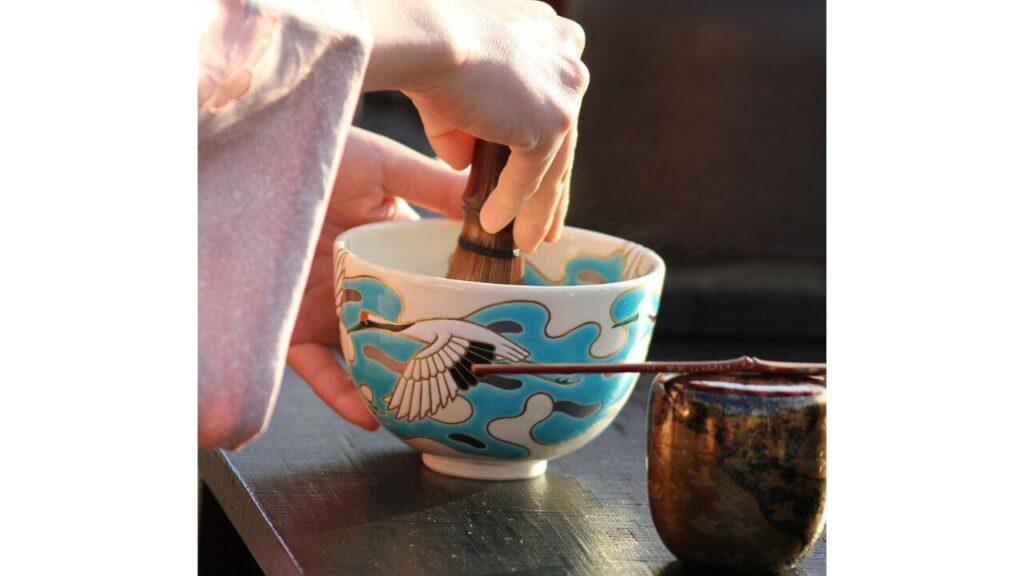
Essential Information for Travelers
Duration and Cost: A typical ceremony lasts about 45 minutes to an hour. Costs vary depending on the venue and type of ceremony, ranging from relatively modest to quite expensive for exclusive sessions.
Location Choices: From traditional tea houses in Gion, the historic district, to ceremonies in temples or even outdoor settings, Kyoto offers diverse environments to enjoy tea ceremonies.
Cultural Significance: Understanding the principles behind the tea ceremony, such as harmony (wa), respect (kei), purity (sei), and tranquility (jaku), can deeply enrich the experience.
Photography: Ask for permission before taking photos. Some ceremonies allow photography, while others may consider it a disruption. Participating in a traditional tea ceremony in Kyoto is about enjoying a bowl of matcha and immersing yourself in a centuries-old tradition that epitomizes the essence of Japanese culture. It’s a reflective and serene experience that every visitor to Kyoto should try at least once.
Learning calligraphy and traditional painting in China
Chinese calligraphy and traditional painting are art forms steeped in history, philosophy, and deep cultural significance. Learning these arts while in China is about acquiring a new skill, immersing oneself in Chinese culture, and understanding its aesthetics and values.
Where to Go
Beijing: As the cultural heart of China, Beijing offers numerous workshops and cultural centers where one can learn calligraphy and painting. The Beijing Culture and Language University often holds classes for foreigners.
Shanghai: Known for its cosmopolitan flair, Shanghai has art studios and cultural institutions offering courses in these traditional arts, often tailored for international visitors.
Hangzhou: Home to the China Academy of Art, Hangzhou provides an immersive experience in learning Chinese art, surrounded by inspiring natural beauty.
Xi’an: With its rich historical background, Xi’an offers a more traditional and authentic experience in learning calligraphy and painting.
Cultural Villages and Art Schools: Smaller towns and villages known for their art heritage, such as the ancient town of Foshan, also offer unique learning opportunities.
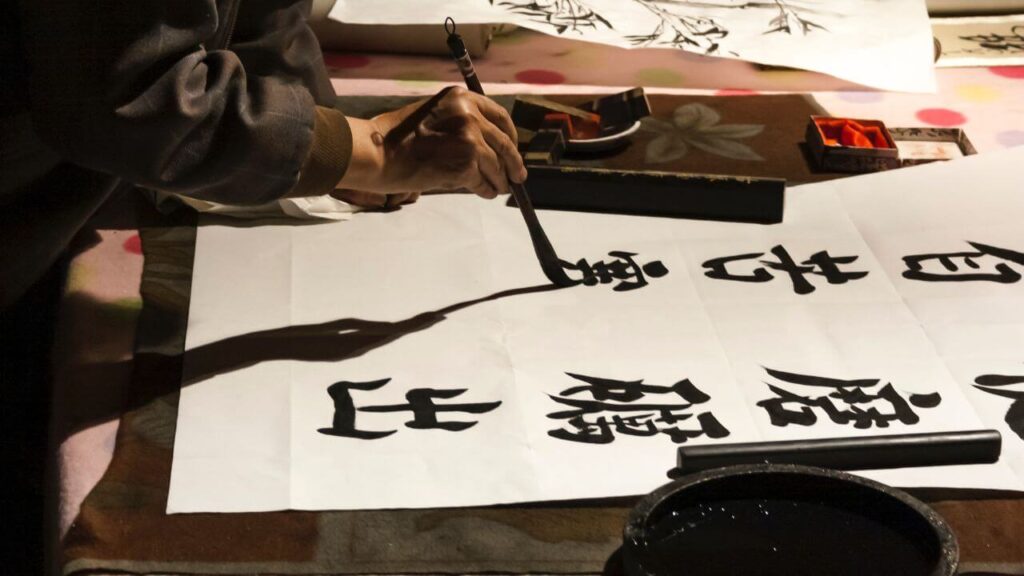
Traveler Tips
Selecting the Right Program: Research to find a program that matches your level of experience and interest, from beginner workshops to more intensive courses.
Language Barrier: Consider programs that offer instruction in English or bring a translation app/device if attending a local class.
Materials and Tools: Most classes provide materials, but purchasing your own calligraphy brush or rice paper as a souvenir can be a memorable part of the experience.
Cultural Etiquette: Show respect for the art form and the instructor. In Chinese culture, these art forms are highly revered, and learning them is considered a serious endeavor.
Patience and Practice: Calligraphy and painting require patience and practice. Embrace the learning process as a meditative and cultural experience, not just a skill to master quickly.
Documentation: Some classes offer certificates upon completion, which can be a nice memento of your experience.
Essential Information for Travelers
Costs: Prices vary widely based on the class’s location, duration, and exclusivity. Some tourist-oriented courses might be more expensive.
Duration: Workshops can range from a few hours to several days, depending on the depth of learning desired.
Cultural Significance: Engaging in these arts provides insight into Chinese philosophical and aesthetic concepts, such as harmony, balance, and the importance of the natural world.
Participating in calligraphy and traditional painting classes in China offers a unique and enriching way to connect with the country’s ancient cultural traditions. It’s an opportunity to learn a new artistic skill and engage with the philosophical and aesthetic principles that have shaped Chinese culture for millennia.
Experiencing a stay in a traditional Hanok in South Korea
A Hanok is a traditional Korean house known for its distinctive architectural features, such as tiled roofs, wooden beams, and sliding doors. Staying in a Hanok offers a unique opportunity to immerse yourself in Korean culture and history, experiencing the traditional Korean way of life.
Best Time to Visit
Spring (April to June): The weather is mild and pleasant, and the cherry blossoms are full, offering a beautiful setting for a Hanok stay.
Autumn (September to November): This season is characterized by clear skies, cool temperatures, and vibrant fall foliage colors, creating a picturesque backdrop for traditional architecture.
The Hanok Experience
Traditional Architecture and Design: Hanoks are designed with nature in mind, featuring courtyards, natural materials, and structures that harmonize with their surroundings. The design also includes ‘ondol,’ a traditional underfloor heating system that keeps the house warm in winter.

Cultural Immersion: Staying in a Hanok often involves experiencing traditional Korean lifestyle elements, like sleeping on a futon on the floor, using sliding doors made of paper, and perhaps even wearing Hanbok, the traditional Korean attire.
Tea Ceremony and Cuisine: Many Hanok stays include a traditional tea ceremony, offering a taste of various Korean teas. Some may also serve traditional Korean breakfast or offer cooking classes.
Locations: While Hanoks can be found throughout South Korea, notable places to stay include the Bukchon Hanok Village in Seoul, Jeonju Hanok Village in Jeonju, and the Andong Hahoe Folk Village.
Traveler Tips
Booking in Advance: Hanok stays can be quite popular, especially in tourist areas, so booking well in advance is advisable.
Etiquette: Respect the traditional nature of the Hanok. This includes being mindful of noise levels, as walls can be thin, and taking care of the property.
Comfort and Accessibility: Be prepared for a traditional sleeping arrangement on futons. This might be a new experience for those used to Western-style beds.
Pack Accordingly: Since you’ll be removing shoes inside, it’s a good idea to bring comfortable indoor slippers.
Exploring the Area: Many Hanok villages are situated in areas of historical significance. Take the time to explore the surroundings for a complete cultural experience.
Staying in a Hanok is not just about accommodation; it’s about living a part of Korean history and culture. It’s an experience that allows you to step back in time and appreciate the beauty and simplicity of traditional Korean life, making it a must-do for anyone looking to connect with South Korea’s heritage deeply.
Experience Thai massage
Thai massage, known in Thailand as “Nuad Thai,” is a traditional healing system combining acupressure, Indian Ayurvedic principles, and assisted yoga postures. This ancient form of massage is renowned for its therapeutic and rejuvenating properties, offering physical and mental benefits. Experiencing an authentic Thai massage in Thailand is not just a spa experience; it’s an immersion into a centuries-old practice deeply rooted in Thai culture.
The Experience
Technique: Unlike Western massage techniques, Thai massage is performed on a floor mat, allowing the therapist to use their body weight to facilitate deeper pressure. The massage includes rhythmic pressing and stretching of the entire body.
Benefits: It’s known to improve flexibility, relieve muscle and joint tension, stimulate internal organs, and balance the body’s energy system.
Duration: A typical session lasts about 60 to 120 minutes, providing ample time for a thorough treatment.
Environment: Authentic Thai massage centers in Thailand often feature a serene and traditional ambiance, enhancing the overall therapeutic experience.
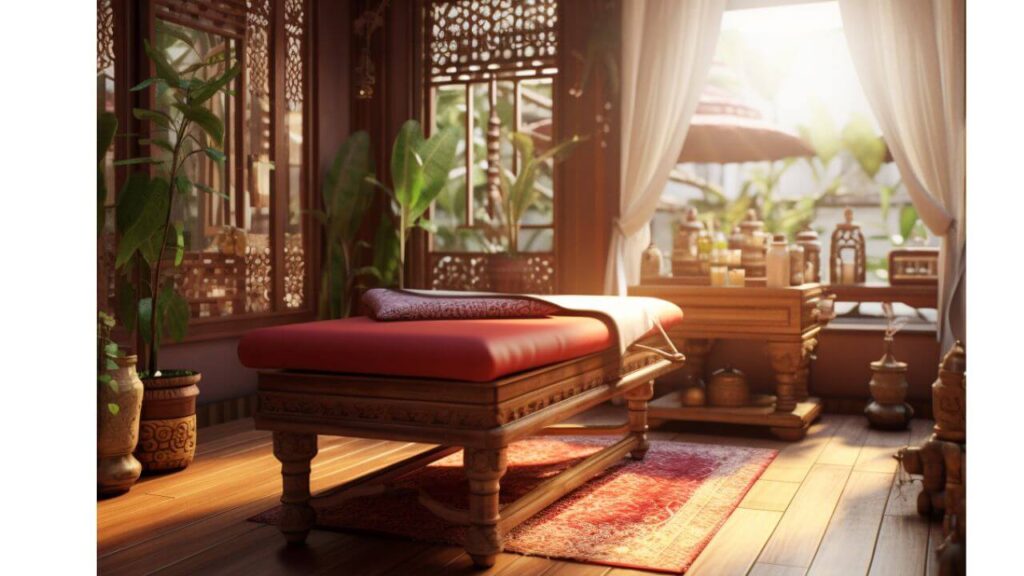
Things to Know Before Going
Clothing: Wear loose, comfortable clothing. You’ll typically be provided with clothes to change into, as Thai massage is performed with clothes on.
Communication: Inform your therapist of any injuries or areas of concern. Communication about pressure levels is also essential to ensure a comfortable experience.
Type of Massage: Be aware that there are various types of Thai massage. Traditional Thai massage is more focused on therapeutic benefits, while others might include oils or focus more on relaxation.
Hydration: Drink plenty of water after your massage. This helps to hydrate your body and remove any toxins that have been released during the massage.
Respect Cultural Norms: Thai massage is deeply respectful and spiritual. It’s important to respect the practice and the practitioner.
Choosing a Massage Center: Opt for reputable massage centers. Look for well-reviewed and professional places to ensure you receive an authentic and high-quality experience.
Physical Preparedness: Be aware that Thai massage can be quite intense. It’s not uncommon to feel sore afterward, especially if you’re not used to deep bodywork.
An authentic Thai massage in Thailand is a unique and enriching experience that goes beyond mere relaxation. It’s a deep dive into Thai culture’s heart, offering physical and spiritual rejuvenation. Whether you’re seeking relief from muscle tension, improved flexibility, or a deeper understanding of Thai cultural practices, a Thai massage is an experience to be cherished.
Visit Chang Mai in Thailand
Chiang Mai, located in northern Thailand, is a city rich in history and culture. Known for its stunning temples, vibrant street markets, lush landscapes, and a more laid-back atmosphere compared to the bustling streets of Bangkok, Chiang Mai offers a unique glimpse into Thai culture.
What to Visit
Temples: Chiang Mai is home to over 300 Buddhist temples. Notable ones include Wat Phra That Doi Suthep, Wat Chedi Luang, and Wat Phra Singh.
Elephant Nature Park: A sanctuary for rescued elephants where visitors can observe and learn about these magnificent creatures in a responsible and ethical environment.
Night Bazaar and Local Markets: The Chiang Mai Night Bazaar is a shopping paradise, offering everything from local handicrafts to street food. Don’t miss the Sunday Walking Street Market for local arts and crafts.
Doi Inthanon National Park: Known as the “Roof of Thailand,” this park features the highest mountain in Thailand, beautiful waterfalls, and hiking trails.
Cooking Classes: Chiang Mai is known for its culinary scene. Participating in a Thai cooking class is a great way to learn about local cuisine.
Best Time to Visit
Cool Season (November to February): This is the best time to visit Chiang Mai. The weather is cooler and more comfortable, making it ideal for exploring the city and surrounding nature.
Festivals: Visiting during traditional festivals like Loy Krathong (November) and Songkran (April) can be particularly special, offering a deep dive into Thai culture.
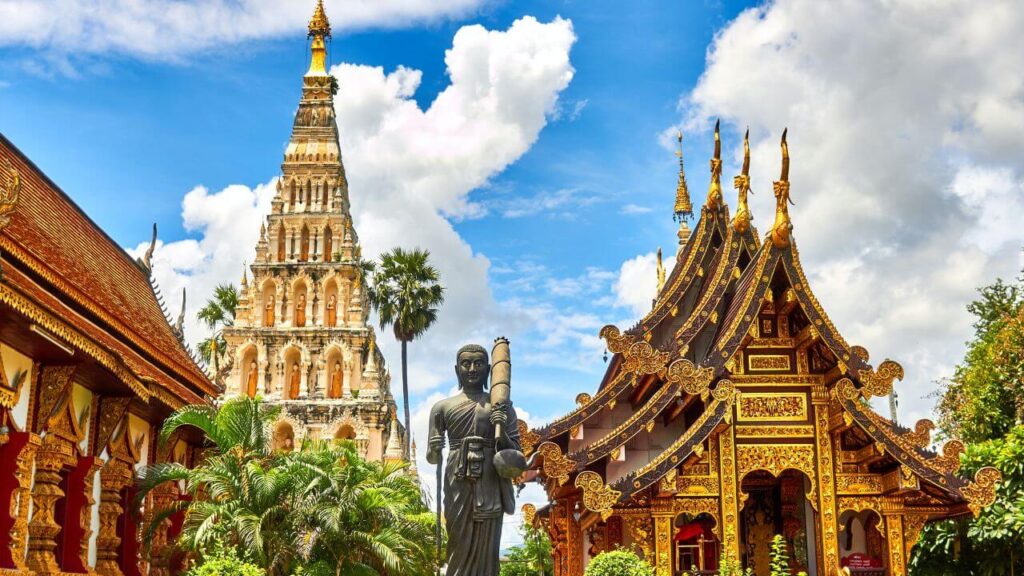
Traveler Tips
Transportation: Renting a scooter or bicycle is a popular way to get around the city. Tuk-tuks and songthaews (red trucks) are also common modes of transport.
Respect Local Customs: Dress modestly when visiting temples. Always remove shoes before entering temple buildings, and be mindful of your behavior in these sacred spaces.
Stay Hydrated: Chiang Mai can be hot, especially during the day. Carry water with you and stay hydrated.
Try Local Food: Northern Thai cuisine is unique. Don’t miss out on local dishes like Khao Soi, Sai Oua, and sticky rice with mango.
Bargaining: When shopping in markets, bargaining is common. Do so politely and with a smile.
Health Precautions: Bring mosquito repellent and sunscreen. Also, be cautious with street food if you have a sensitive stomach.
Cultural Experiences: Engage in cultural activities like meditation retreats, traditional Thai massage, or visiting an ethnic hill tribe village.
Chiang Mai is a treasure trove of cultural experiences, natural beauty, and historical richness. Whether you’re exploring ancient temples, enjoying the local cuisine, or immersing yourself in the natural landscapes, Chiang Mai offers a memorable and authentic Thai experience.
Visit Hoi An Town in Vietnam
Hoi An, a UNESCO World Heritage Site in Vietnam, is a beautifully preserved example of a Southeast Asian trading port dating from the 15th to the 19th century. Known for its well-preserved Ancient Town, cut through with canals, the town reflects a fusion of indigenous and foreign cultures, particularly Chinese, Japanese, and later European influences.
Experiences in Hoi An
Ancient Town: The heart of Hoi An is filled with charming historic architecture, old canals, and vibrant street life. Key sights include the Japanese Covered Bridge and the Fujian Chinese Congregation Assembly Hall.
Tailoring Shops: Hoi An is famous for its tailoring shops and is an excellent place to get custom-made clothing.
Night Market and Lanterns: The Night Market is a spectacle of lights and colors, especially beautiful when the lanterns are lit.
Culinary Tours and Cooking Classes: Known for its unique cuisine, culinary tours and cooking classes are popular, offering insights into local dishes like Cao Lau and Banh Mi.
Cycling Tours: Exploring the countryside around Hoi An by bike is a great way to see the rice paddies, traditional villages, and local life.
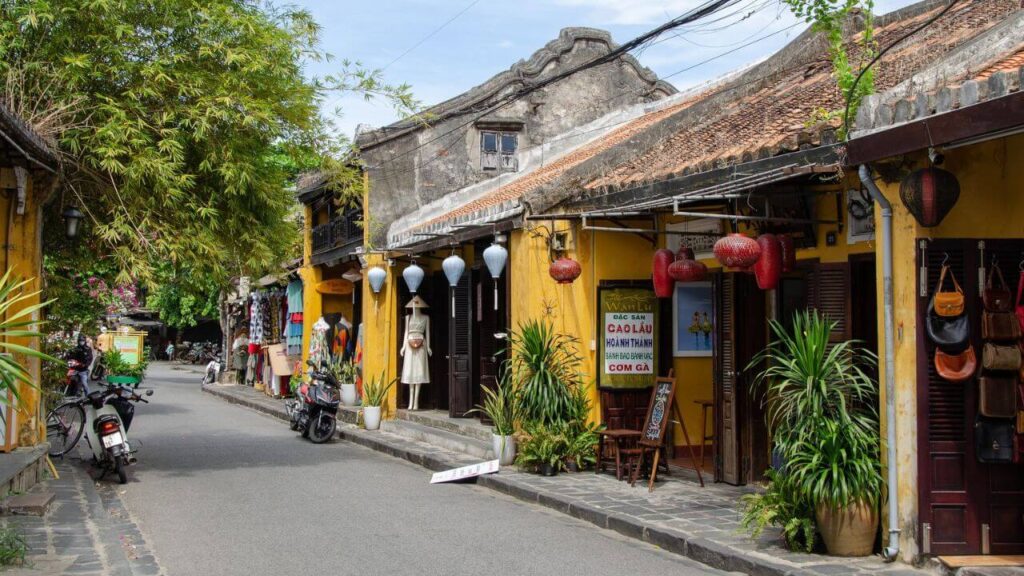
Best Time to Visit
February to April: This period sees the least amount of rain and moderate temperatures, making it ideal for exploring the town and surrounding countryside.
Festivals: The Lantern Festival, happening monthly on the full moon, is especially enchanting and offers a deeper cultural experience.
Travel Tips
Getting Around: Hoi An is a pedestrian-friendly town, and its Ancient Town area is best explored on foot. Bicycles are also a great way to get around both the town and the surrounding countryside.
Cultural Etiquette: Respect local customs and traditions. Dress modestly when visiting temples or religious sites.
Local Cuisine: Try local specialties and street food. Hoi An’s food is a highlight and offers a mix of flavors and influences.
Shopping: Hoi An is known for its tailor shops and traditional lanterns. It’s a great place to buy souvenirs but be prepared to bargain in markets.
Accommodation: There’s a range of accommodation available, from hostels to luxury resorts. Staying near the Ancient Town will keep you close to most attractions.
Weather Preparedness: Be prepared for hot and humid conditions, especially from May to August. Rain gear can be essential in the rainy season (September to January).
Language: While English is widely spoken in tourist areas, learning a few basic Vietnamese phrases can enhance your experience.
Visiting Hoi An offers a unique blend of historical architecture, vibrant cultural scenes, exquisite cuisine, and a glimpse into the traditional Vietnamese way of life. Its serene atmosphere, combined with the rich tapestry of history and culture, makes Hoi An a must-visit destination in Vietnam.
Visit George Town in Malaysia
George Town, the capital city of Penang, Malaysia, is renowned for its unique architectural and cultural townscape, blending Eastern and Western influences. It’s a UNESCO World Heritage Site known for its historic buildings, vibrant street art, delicious street food, and multicultural heritage.
What to See
Street Art: George Town is famous for its fascinating street art, particularly around Armenian Street. These murals often incorporate real objects into the artwork.
Historic Buildings: The city is rich in colonial architecture with landmarks like Fort Cornwallis, the Pinang Peranakan Mansion, and the Cheong Fatt Tze Mansion (Blue Mansion).
Cultural and Religious Sites: Visit the Kek Lok Si Temple, Khoo Kongsi, and Kapitan Keling Mosque to experience the city’s diverse religious heritage.
Food and Markets: Penang is known as Malaysia’s food capital. Explore hawker centers like Gurney Drive to taste local dishes like Char Kway Teow and Penang Laksa.
Penang Hill and the Botanic Gardens: For nature lovers, these sites offer a green escape with great views and walking trails.

Best Time to Visit
Dry Season (December to February): The weather is more comfortable with less rainfall, making it an ideal time for exploring the city.
Festivals: Visiting during cultural festivals like Chinese New Year or Deepavali can be particularly vibrant and offer a deeper cultural experience.
Traveler Tips
Transportation: George Town is walkable; exploring on foot is often the best way to see the street art and heritage buildings. Buses and ride-hailing apps are also convenient for longer distances.
Respecting Cultural Norms: As a multicultural city, respecting the various cultural and religious practices is important. Dress modestly when visiting religious sites.
Stay Hydrated: The climate can be hot and humid. Carry water, wear sunscreen, and take breaks in shaded areas.
Food Exploration: Don’t hesitate to try street food, as Penang is known for its culinary diversity. Night markets are also a great place to sample local flavors.
Accommodation: Staying within the World Heritage zone can be convenient for exploring the city’s main attractions.
Language: English is widely spoken, but learning a few basic Malay phrases can enhance your experience.
Photography: For those interested in photography, the city offers a rich tapestry of subjects, from historic architecture to dynamic street scenes.
George Town is a vibrant tapestry of history, culture, and cuisine. Its blend of colonial heritage, traditional Chinese and Indian influences, and modern artistic expressions make it a unique urban exploration destination. A visit here offers a visual feast and a deep dive into Malaysia’s multicultural identity.
Bagan- Myanmar as one of the Authentic Cultural Experiences in Asia
Old Bagan, located in the Mandalay Region of Myanmar, is an ancient city and a UNESCO World Heritage Site. Famous for its archaeological zone, Old Bagan is home to thousands of historic Buddhist temples and stupas, making it a significant cultural and historical destination.
Best Things to Do
Temple Exploration: Visit iconic temples such as Ananda, Dhammayangyi, and Thatbyinnyu. Each temple has unique architectural styles and histories.
Hot Air Balloon Ride: Experience a breathtaking sunrise or sunset view of Old Bagan from a hot air balloon, offering a panoramic view of the temple landscape.
Visit Local Villages: Explore nearby villages for a glimpse into the local life and culture. Interacting with the friendly locals can be a highlight.
Cycling or E-biking: Rent a bike or an e-bike to explore the temple plains. It’s an eco-friendly way to navigate the vast archaeological zone.
Sunrise and Sunset Views: Catching a sunrise or sunset over the temples is a must-do. Popular spots include Shwesandaw Pagoda and Pyathada Pagoda.

Best Time to Visit
Cool Season (October to February): The weather is more comfortable with cooler temperatures and less rain, ideal for exploring the temples and outdoor activities.
Avoiding the Rainy Season: June to September is the monsoon season in Myanmar, which can make some temple sites less accessible.
Traveler Tips
Respect Local Customs: Dress modestly, especially when visiting temples. It’s customary to remove shoes and socks before entering temple grounds.
Stay Hydrated: The climate can be hot, especially during midday. Carry water, wear sunscreen, and use a hat or umbrella for sun protection.
Cultural Sensitivity: Be respectful when taking photographs, especially of monks and local people. Always ask for permission first.
Accommodation: Stay in the nearby town of Nyaung-U or New Bagan for more accommodation options and amenities.
Health Precautions: Carry basic first-aid supplies and be cautious with street food to avoid stomach upsets.
Local Currency: Have enough local currency (Kyat) for small purchases, as many local vendors do not accept credit cards.
Guided Tours: Consider a guided tour for more in-depth historical and cultural insights about the temples and the region.
Old Bagan is a remarkable destination, offering a journey back in time through its awe-inspiring temples and stupas. It’s a visual feast and a spiritual experience, providing a unique glimpse into Myanmar’s rich historical and cultural heritage. Whether exploring by foot, bike, or from the sky, Old Bagan is a must-visit for anyone interested in history, architecture, and the beauty of ancient civilizations.
Learning about Uzbek handicrafts like carpet weaving in Uzbekistan
With its rich cultural heritage, Uzbekistan is renowned for its vibrant and intricate handicrafts, especially carpet weaving. This traditional craft is not just an art form; it reflects Uzbek history and culture, with each region offering its unique patterns and styles. Learning about and witnessing carpet weaving in Uzbekistan is an experience that blends cultural insight with artistic appreciation.
The Experience
Workshop Visits: Many towns in Uzbekistan have workshops where you can see artisans at work. Cities like Bukhara, Samarkand, and Khiva are famous for their carpet-weaving traditions.
Hands-On Learning: Some workshops offer short courses or demonstrations where visitors can try their hand at weaving under the guidance of skilled artisans.
Understanding Patterns and Techniques: Uzbek carpets are known for their distinctive patterns, colors, and weaving techniques. Each pattern often has a story or symbolism behind it, deeply rooted in Uzbek culture.
Museum Visits: Museums in major cities often have sections dedicated to Uzbek textiles and carpets, providing historical context to the craft.
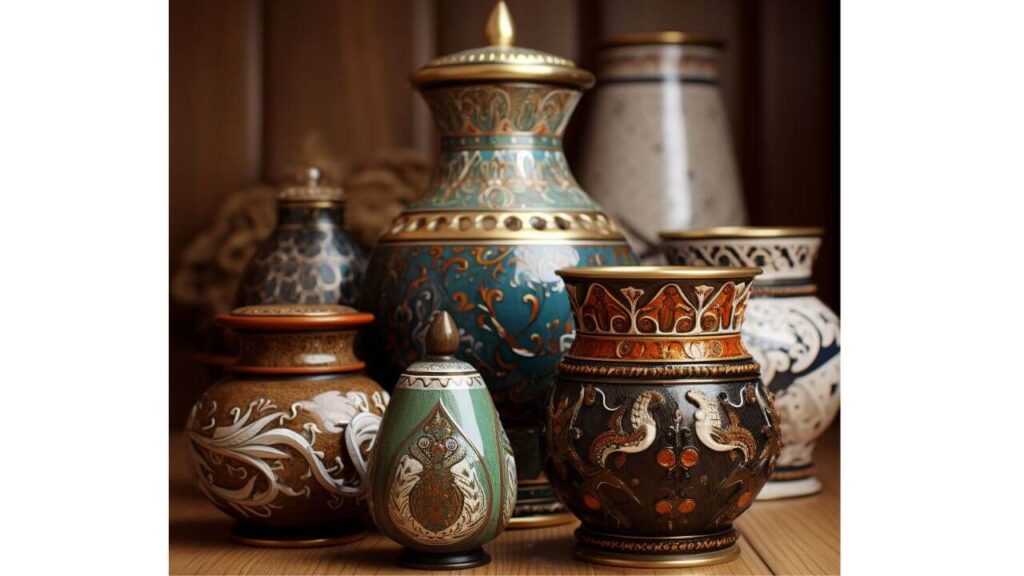
Things to Know
Regional Variations: Different regions in Uzbekistan have unique styles and methods. It’s interesting to see how the designs and techniques vary from one area to another.
Time-Consuming Process: Carpet weaving is a labor-intensive process that can take months or even years to complete a single carpet, depending on the size and complexity.
Purchasing Carpets: If you intend to buy a carpet, it’s important to know about the quality, type of dye used, and the material. Bargaining is common in the markets, but knowing the value of the craftsmanship is crucial.
Cultural Respect: Showing interest and respect for the artisans’ skills enhances the experience. This craft is a source of pride and livelihood for many locals.
Language Barrier: While English is spoken in tourist areas, having a guide or learning a few basic phrases in Uzbek or Russian can be helpful, especially in more remote areas or traditional workshops.
Documentation: If you buy a carpet, ensure you get the necessary documentation for export, as there may be regulations on taking cultural artifacts out of the country.
Experiencing carpet weaving in Uzbekistan is not just about observing a craft; it’s about immersing yourself in an ancient tradition that tells the story of a nation’s identity and history. Whether you’re participating in a workshop, visiting a museum, or simply admiring the skill of local artisans, the world of Uzbek carpets offers a colorful and enlightening window into the heart of Central Asian culture.
Exploring the unique landscapes of Cappadocia with a local guide
Cappadocia, located in central Turkey, is renowned for its extraordinary landscapes, characterized by fairy chimneys, unique rock formations, and historical cave dwellings. Exploring this otherworldly terrain with a local guide not only enhances the experience with rich historical and cultural insights but also provides access to lesser-known spots and stories of the region.
The Experience
Guided Tours: Local guides offer various tours, including hiking, horseback riding, and even ATV tours, which allow you to explore the unique geography of the region closely.
Cave Churches and Cities: Visit ancient cave churches with frescoes in the Göreme Open Air Museum and explore underground cities like Derinkuyu or Kaymakli.
Hot Air Balloon Ride: While not necessarily with a guide, a balloon ride is a quintessential Cappadocia experience, offering a stunning aerial view of the landscape at sunrise.
Local Villages: A guide can take you through traditional villages like Uçhisar and Ortahisar, where you can learn about local life and history.
Photography: Guides know the best spots and times of day for photography, ensuring you capture the magical scenery.

Ideal Time to Visit
Spring (April to June) and Autumn (September to November): These seasons offer mild weather, making it comfortable to explore the outdoors. The landscape is particularly beautiful in spring with blooming flowers and in autumn with golden hues.
Avoiding the Crowds: Early mornings are great for balloon rides and for avoiding crowds at popular spots.
Things to Know
Wear Comfortable Shoes: The terrain in Cappadocia can be uneven and rocky, so sturdy footwear is essential.
Weather Variances: The region can experience temperature swings, so dressing in layers is advisable.
Respect the Environment: The fairy chimneys and rock formations are delicate. It’s important to follow guidelines to avoid damaging the landscape.
Cultural Sensitivity: While interacting with locals or visiting religious sites, it’s important to be respectful of local customs and traditions.
Local Cuisine: Try regional specialties like testi kebabs and pottery kebabs. A local guide can recommend authentic eateries.
Choosing a Guide: Opt for a certified local guide for the best experience. They can provide deeper insights into the region’s history, geology, and culture.
Exploring Cappadocia with a local guide offers a more enriched experience, taking you beyond the typical tourist path and delving deeper into the heart of this unique region. The combination of stunning natural beauty, rich history, and the warmth of local hospitality makes a guided tour in Cappadocia an unforgettable adventure.
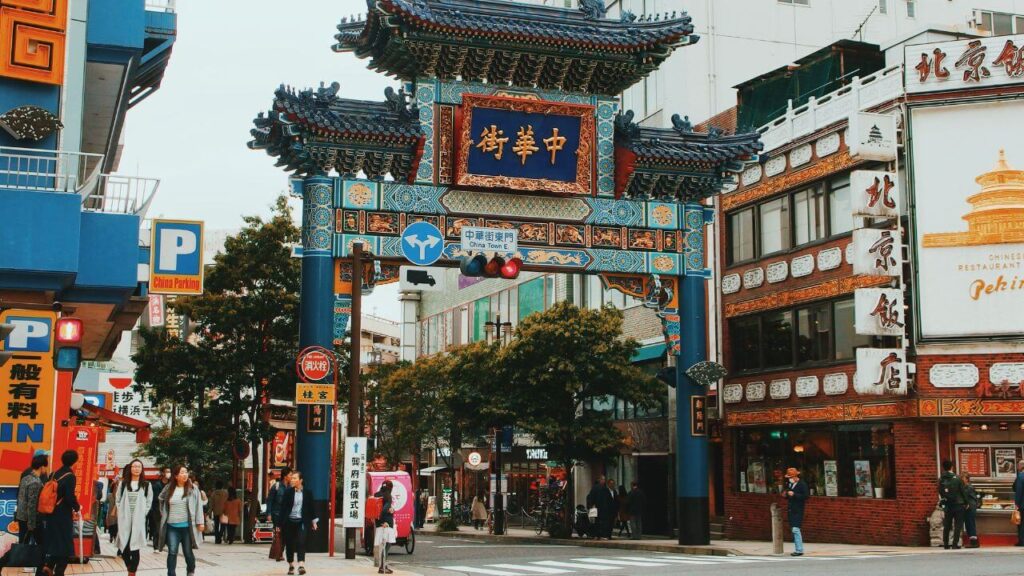
In conclusion, delving into authentic Asian cultural experiences offers an unparalleled journey into a world rich with history, tradition, and vibrant contemporary life. Each encounter, from Japan’s serene tea houses to Hoi An’s historic streets, provides a deeper appreciation and understanding of this vast and varied continent. Whether you’re watching the sunrise over the temples of Bagan, learning ancient crafts in Uzbekistan, or sampling the culinary delights of Penang, these experiences are more than just activities; they are profound connections to the heart of Asian culture. As you depart from these authentic encounters, you carry with you souvenirs and a deep connection to the people, traditions, and stories that weave the intricate tapestry of Asia. Embrace these authentic cultural experiences as gateways to broaden your horizons and deepen your understanding of this incredible continent’s enduring spirit and legacy.

